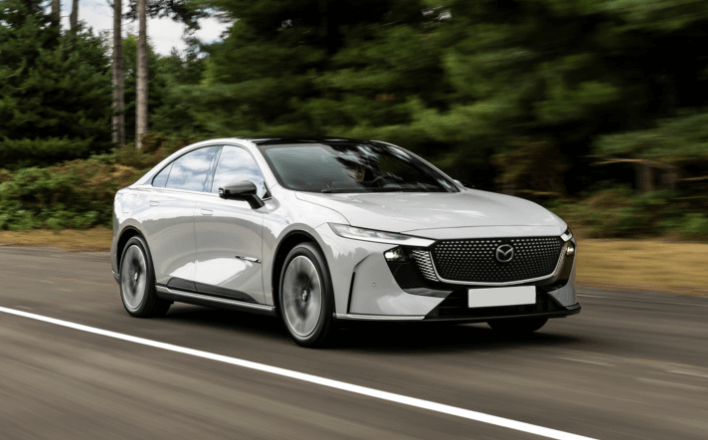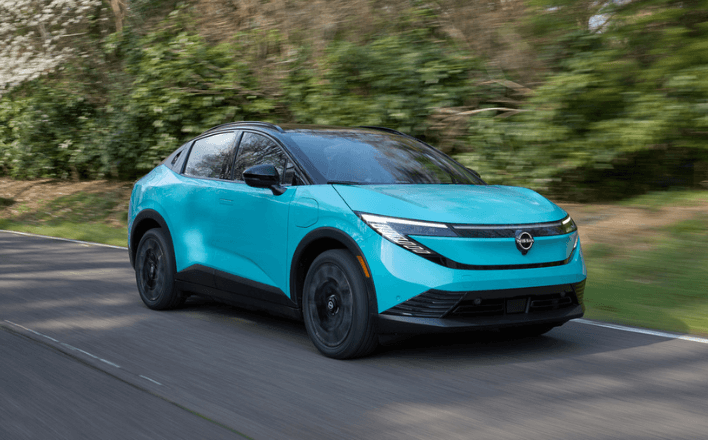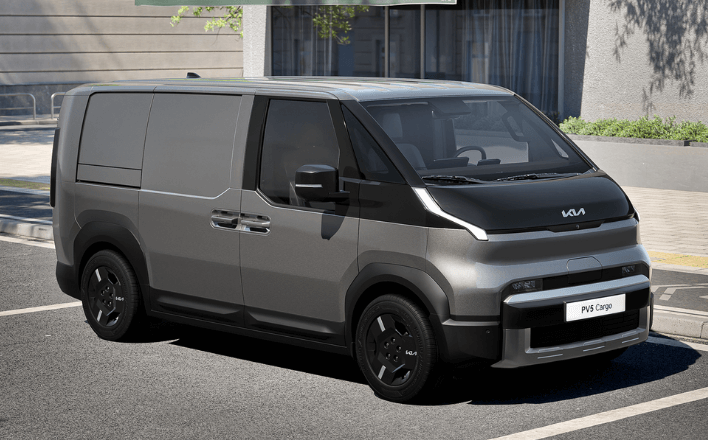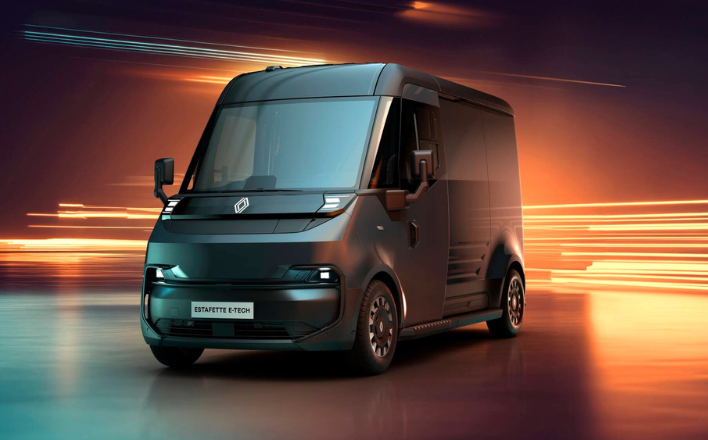22 mins read
The electric vehicle market is booming. In June 2025, EVs made up 22% of new vehicle sales in Ireland, while the United Kingdom saw a quarter of all new cars sold being pure electric. In both cases, EVs were the second most popular fuel type, behind petrol. With this growing demand, and the legislation that has helped in part to drive it, vehicle manufacturers have brought a growing portfolio of makes and models of EV to market. In 2015, there were around twenty different makes and models of EV available to buy in these markets. Fast forward to 2025 and that figure is 349, and that’s just cars. We’ve seen not only a significant improvement in range and charging speeds, but a great diversification of the cell chemistry used and types of vehicle available, and that trend is continuing to grow. So, if you’re looking to expand or replace your fleet, here are my picks for EVs to look out for in 2026, complete with top tips on the pitfalls to avoid with certain models.
Mazda 6e
With the notable exception of Nissan’s pioneering LEAF and greatly underestimated Ariya, Japanese EV manufacturers have been largely caught napping by the rEVolution that is underway. This has led to missed opportunities with EVs that are overpriced and underspecced, not least the joyous Honda e that was hobbled by a #So2015 range of 160 km per charge, and a snooze-inducing fast charge speed of around 35 kW. Finally, one of the non-Nissan Japanese OEMs has taken EVs seriously: in 2026, Mazda shall launch the 6e, a very competent electric luxury saloon that would make the perfect motorway mileage muncher for the businessperson on the go. Admittedly they’ve teamed up with Chinese partner Changan to make it happen, but Mazda’s engineers have been responsible for refining the setup of the vehicle.
The Standard Range 6e is equipped with a 68.8 kWh lithium iron phosphate (LFP) battery, which is cobalt-free, ethical, cheap, long-lasting and safer than the lithium nickel manganese cobalt oxide (NMC) batteries that have powered most makes and models EVs in Ireland and the UK until recently. A motor power of 189 kW means that the 6e is no slouch, and it’s equally quick when stopping at a motorway service station, pulling up to 200 kW from a fast charger and topping up from 10 – 80% State of Charge in 22 minutes, which is less than the average dwell time at an motorway service station in Ireland. These specs make it a strong and arguably more ethical and refined rival to the Hyundai IONIQ 5, with aerodynamics that make it less of a flying brick, returning around 4 miles per kWh, or 15.5 kWh per 100 km.
Some fleet managers may be tempted to opt for the long-range version of the 6e, which has an NMC battery that boosts range from the 475 km of the Standard Range to nearly 550 km. However, the Long Range 6e has a severe drawback: its maximum charge power is less than half of that of the Standard Range. This means that a 10 – 80% top-up is expected to take around 45 minutes, courtesy of the car maxing out at just 95 kW. As such, the Long Range version of the 6e should be avoided, not least since the Standard Range version easily gets you from Dublin to Dingle or Dunfanaghy on a single charge, with Dingle to Dunfanaghy requiring only the briefest of stops at one of the high power chargers along the route – a stop that you’d be grateful for in what is normally just shy of a seven hour journey.
Why it might be good for your fleet? – the 6e combines Mazda’s refined cabin and ride comfort with more than ample range per charge, a fast-charging speed and an ethical battery. The fact that the cheaper Standard Range model is genuinely the better performer of the two is an added bonus for fleet managers looking for attractive vehicles for executives and senior personnel that don’t break the bank.

Nissan LEAF
The new LEAF launches in Ireland in early 2026, and it’s a radical departure from the original, bulletproof workhorse of a hatchback. The 2026 model is now an aerodynamic crossover, which may sound like a bit of an oxymoron, but it has an entirely respectable drag coefficient of 0.25, which puts it on par with the two-seater space capsule of a hybrid that was the Mk1 Honda Insight, and that vehicle was designed to be as efficient as possible.
The new LEAF shares the same platform as the Ariya, so the battery and fast charging socket are completely different from those that have been found on the LEAF since its launch in 2010. Until now, the LEAF has used the “CHAdeMO” socket for fast charging, which is very much the Betamax of the fast-charging format war, which has been comprehensively won by “CCS” – in fact, the old LEAF was just about the only EV that hadn’t yet adopted CCS. Also, the old LEAF had no cooling system for its battery, so some variants were known to get hot on days when the car was fast charged several times in a row, leading to reduced performance and increased battery degradation. Conversely, the new LEAF has the same CCS socket that is found on all other modern EVs and fast chargers across Ireland and Europe, and a liquid-based cooling system on its battery, which quickly removes heat generated during fast charging before it becomes a problem. The old LEAF’s party piece was its ability to power your home through vehicle-to-grid (V2G). The good news is that the new LEAF can do this too. Not only this, but the new LEAF can additionally power any electrical device with a 3-pin plug, which can be plugged into the car’s adapter; this is known as vehicle-to-load (V2L). The combination of V2L and V2G means so you can plug anything into the new LEAF, be it a kettle or your entire house or office. This has the potential to reduce your energy bills and to keep your tools and devices powered when your work takes you to remote areas; it also comes in handy for powering promotional stands at outdoor events.
Battery options are 52 kWh and 75 kWh, and energy consumption is an improved 4.38 miles per kWh or 14.19 kWh per 100 km, which will return a range of up to 432 km for the 52 kWh battery and 600 km for the 75 kWh variant; expect nearer to 485 km real-world motorway and national road range for the latter, based on its official range estimate from the notoriously more thirsty and highway-focussed US testing standard. The new LEAF supports up to 150 kW fast charging (105 kW on the smaller battery variant), which should enable a 15 – 80% charge in about half an hour. Not only are the batteries cooled, but they can also be heated when required to boost performance in cold weather and maximise charge speeds. The new LEAF can scavenge heat from the car’s onboard charger to help to heat the batteries, too, further improving the efficiency of the vehicle as a whole.
Boot space is improved to 437 litres, or 1052 litres with the rear seats down. If that’s not enough, another nice touch is the ability to tow up to 975 kg braked trailer weight, adding to the car’s versatility.
Nissan has also extensively upgraded the infotainment on the new LEAF, giving it Google built-in, which significantly improve the car’s sat nav, which can now map out ideal charging stops on longer journeys. The new LEAF also has over-the-air software updates, which will keep it packed with the latest features over the years.
Production will be local(ish) at Nissan’s plant in Sunderland, which has the added bonus of reducing the carbon footprint of getting your new car to your depot.
Why it might be good for your fleet? Nissan has turned over a new LEAF, offering a practically sized and well-specced crossover with plenty of features and storage. The new LEAF may appeal to fleet customers who may have shunned the previous model for being a hatchback, and the switch to a modern battery design and now-industry-standard “CCS” fast charging socket means it will be easy and reasonably quick to keep this EV topped up on the go, not that many (if any) charging stops will be needed with the new long-range battery option. Nissan’s track record on solid EV reliability – especially with the LEAF – should make this car as trouble-free as it is feature-rich.

Kia PV5
Of course, many fleets need to transport cargo as well as people, so it would be remiss of this review to not consider the most promising electric vans on the horizon. The electric van market has lagged behind electric cars, not just in terms of sales, but the quantity and quality of vehicles on offer. Historically, electric vans have been overpriced and underspecced vs their car counterparts, but this is starting to change.
One of the most exciting developments is the arrival of the first electric van from Kia, the PV5. Kia is renowned for the quality of its electric cars, such as the indefatigable Niro EV and the ultra-fast-charging EV6. Kia is also one of the market leaders in the efficiency of its powertrains, which will be particularly valuable for a heavily-laden van to eke out as many kilometres as possible. Available as a cargo van, people carrier or side-entry wheelchair accessible vehicle, this versatile rival to the Ford Transit Custom and VW ID Buzz Cargo was designed as an EV from the start, rather than compromising on design by squeezing the battery into a chassis that was designed to accommodate a diesel engine. The PV5 can accommodate 4-5 cubic metres and around 790 kg of cargo, depending on specification, with an impressive loading height of 419 mm. A chassis cab variant allows conversions to other van styles such as box, freezer or drop side, which shall be performed by Kia. The Essential trim is loaded with car-esque creature comforts that many van drivers have come to expect in recent years, and the relatively inexpensive Plus trim upgrade adds vehicle-to-load (V2L) capability, which allows you to power your tools from the van’s traction battery if you’re on a job with no power supply nearby. The PV5 also features Android Auto, over-the-air software updates and inbuilt Geotab fleet management software. If you’re worried about how well Kia’s first attempt at making a van will stand the test of time, the seven-year, 150,000 km warranty should put your mind at ease.
Standard and Long-Range battery variants will be available, with the former consisting of a 51.5 kWh battery paired with an 89.4 kW motor, and the latter having a 71.2 kWh battery and 120 kW motor. An optional 22 kW onboard charger allows the PV5 to hoover up electrons as quickly as possible from home, depot and destination (“Type 2”) charge points and add a genuinely useful amount of range while you’re on site or stopping for a bite to eat. Interestingly, despite Kia being one of the early movers on 800-volt battery architecture, the PV5’s battery variants are both a more conventional 400 volts, but their ability to charge at up to 150 kW on a fast charger provides a 10 – 80% top-up time of under half an hour. The estimated WLTP range – which is known to be a bit on the optimistic side – is 294 km for the Standard Range PV5 and 400 km for the long-range variant. This will come down somewhat when driving on the motorway with a heavy load, but Kia’s motor efficiency, combined with sensibly sized 16” alloys that value practicality over vanity while still managing to look the part, should ensure ample range around town and on twisty country roads.
Technically the first PV5s arrive in Ireland in November, but more versions, such as long wheelbase and high roof variants, arrive in 2026. As for price, when it comes to the theme of electric vans having a high price and low spec, Kia has flipped the script, offering a van that is bursting with genuinely useful tech from €33,230 + VAT.
Why it might be good for your fleet? – Kia’s track record on the build quality and efficiency of their electric cars should translate to a van that is cheap to run and rarely lets you down, all for a very reasonable price. For businesses that use power tools in remote locations, vehicle-to-load is a feature that you’ll wonder how you used to cope without. The inbuilt fleet management software should make fleet managers’ lives much easier, too.

Renault Estafette
Renault has teamed up with Volvo to create Flexis, a new brand that focusses on delivering electric, software-defined vehicles (SDV) for the logistics sector. In 2026, the first results of this collaboration shall be seen when Renault launches three new electric vans, all based on the same underpinnings and promising flexibility, ergonomics, connectivity and reduced running costs. The mid-sized Trafic will have the same turning circle as the Renault Clio and a low height to allow access to multistorey car parks, while the Goelette features chassis cab, box and tipper options with support for an exceptionally broad range of customisations for the specific needs of your business.
The Estafette is singled out here because it is the largest of the three vehicles, yet remains compact at 5.27 by 1.92 metres. An interior door links the cabin to the cargo bay, and the Estafette’s height of 2.6 metres allows most adults to move around the cargo bay without having to stoop down. Details of the technical specifications are scarce at the moment, but Renault’s new battery division Ampere is responsible for delivering the batteries, and given the advanced architectures that they’re developing at the moment, that bodes well for range and efficiency for a vehicle of this size.
Crucially, Ampere is also simplifying the software for these vans as part of the SDV approach. Most vehicles have tens of electronic control units (ECUs) that deal with different functions, were possibly supplied by different suppliers, and were never really designed to talk to each other – a clunky approach that results in vast efforts to translate all of those ECUs and get them to work together, and can all too easily go wrong and require software updates to fix. Ampere is simplifying the architecture of Renault’s new vans by providing a centralised software architecture, complete with an intelligent and connected operating system, which should smooth the operation of the vehicle, improve its reliability, and ensure that any updates are performed quickly. Impressively, Renault claims that this approach will allow the vehicle to remotely diagnose issues so that action can be taken, such as scheduling maintenance or taking mitigating measures to slow further degradation. Not only this, but updates and features can be applied that are tailored to specific fleets and their needs, from ambulances to refrigerated vehicles. All of this could make Renault’s new van range a real winner with fleet managers.
Why it might be good for your fleet? – Renault is one of the earliest movers in the EV space, and has been making electric vans for well over a decade. The new Flexis and Ampere-engineered models represent a huge step forward in electronics and software design, and vehicle customisation options too, which should lead to minimal niggling glitches and a van that is tailored and optimised to your needs from both hardware and software perspectives, making it a very user-friendly option for fleets to consider.

Honourable mentions
An honourable mention for other EVs to look out for in 2026 goes to the 4-wheel drive version of the Ford E-Transit Custom, which should make light work of some of the more tortuous backroads and dirt tracks down which some of your clients and jobs may be based. Also, if we’re lucky, our right-hand drive markets may be treated to the launch of the revived and electrified Renault Twingo, a compact and well-specced EV that boasts instantly recognisable styling that brings the 1990s icon into the 2020s, with impressive efficiency of over 6 miles per kWh / around 10 kWh per 100km, and a starting price of under €20,000! Finally, Honda, who I lambasted earlier for underspeccing the E, are allegedly planning to launch two “0” EV models in 2026. The first is an SUV, but the prototype of the second variant, a saloon, has some of the most striking interior and exterior design language of any modern car. Technical details again are limited at present, but Honda claims that it has focused on energy efficiency for the 0 series, and reckons that these EVs will be able to charge from 15 – 80% in under 15 minutes. This could allow any overpricing to be forgiven by personnel who want a practical company car that truly stands out from the crowd – and having a head-turning car in your fleet could be a powerful way to promote your business.
